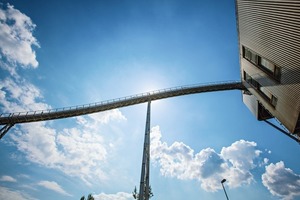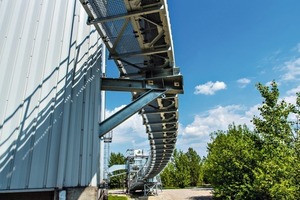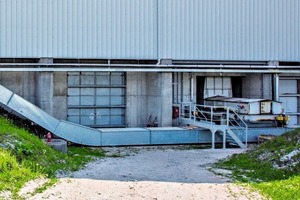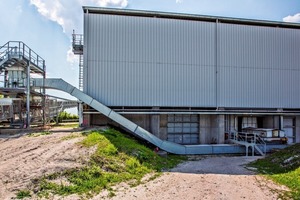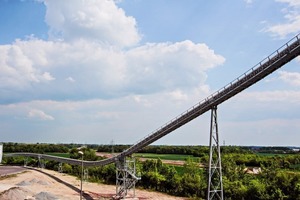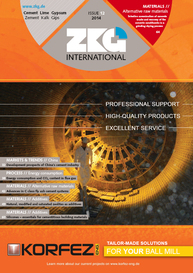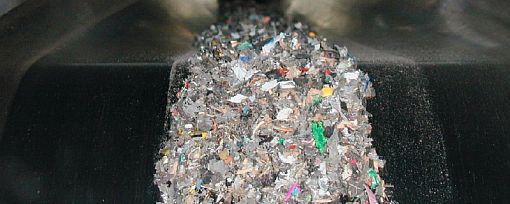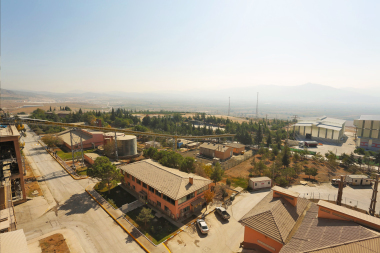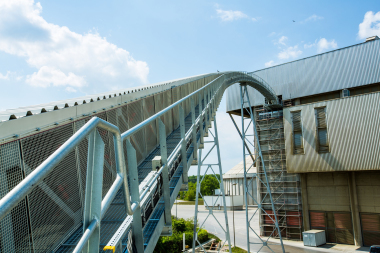Operational gains with minimal disruption and without any material loss
Schwenk Zement KG, headquartered in Ulm/Germany, planned to replace its old drag chain conveyor line with a modern pipe conveyor (Fig. 1) from the Beumer Group. Requiring a solution that would transport alternative fuels such as crushed plastic material, textiles and paper from the warehouse to the feeding system of the oven in their cement plant in Bernburg/Saxony-Anhalt, Germany, this fully closed conveying system makes transporting bulk material more environmentally friendly and energy efficient. Maintenance costs are also considerably lower and the system can be optimally adapted to the ambient conditions.
Schwenk´s product diversity and production capacity makes the cement plant in Bernburg one of the largest and most efficient building material plants in the country. The production of cement along the river Saale has a rich history due to the prevalence of high-quality deposits of limestone in this area. The plant has been in existence since 1960. Schwenk took over the plant in 1990 and tore down the existing systems to build an entirely new plant. Today, the local product portfolio includes a wide range of efficient, specialised cement marked by consistently high quality. The company produces the ideal product using modern mixing technology, as required for tunnel, road and well construction, as well as for geothermal and environment engineering.
One topic of great importance to the Bernburg plant is sustainable production. Production of cement has always been one of the most energy-intensive operations. This is why Schwenk minimizes the use of primary fuels such as coal and oil and focuses increasingly on substitute fuels. These substitute fuels are mainly a mixture of high calorific waste materials, comprised mostly of plastic and packaging residues and textiles. They are processed to high-grade fuels with defined product parameters in external processing plants.
Up until now, Schwenk relied on a drag chain conveyor line for transporting the fuels from the storehouse (Fig. 2) to the feeding systems of its main burner. The baffle plates on these mechanical continuous conveyors are mounted to an endless chain, transporting the bulk material in a trough. “We had been using this system for more than ten years. This meant that we had to put more and more maintenance work into it”, says Dirk Fabian, production manager at Schwenk in Bernburg.
Another problem: after further development of the dosing technology, the drag chain conveyor was no longer able to transport enough bulk material, with a density of only 0.2 t/m3, to the weigh feeders (and thus to the main burner). “We were looking for an alternative solution that would be ecological as well as low in maintenance”, explains Dirk Fabian. In addition, the new conveyor should also be optimally adapted to the curved routing in the plant.
For Schwenk, the Beumer Group from Beckum/Germany was their first choice supplier of the optimal conveying technology, as the building materials manufacturer has a long-standing and close partnership with Beumer as an internationally operating system supplier. The latter has bundled its comprehensive expertise in the building materials industry and established different Centres of Competence, in order to offer optimal support for global building material manufacturers by offering single-source solutions. The “Pipe Conveyor” segment is such a Centre and is in charge of worldwide project management and sales in its segment. Thus, they collect and process the expertise from the individual local group companies and pass it on to the global Group experts in each respective field.
“Together with the management team in Bernburg, we developed a solution that is tailored exactly to match Schwenk’s requirements”, says Michal Mikulec, managing director at Beumer Group Czech Republic a.s. and supervisor for this project. Their first idea was to combine a new drag chain conveyor with several open belt conveyors, but it was quickly abandoned. It became apparent that a pipe conveyor was the best solution offering environmental protection and low maintenance. “Its closed design protects the environment from transported goods falling down. Another advantage is the lack of dust development on the running line”, explains Mikulec.
These conveyors offer many other advantages. They are able to navigate long distances and tight curve radii. Due to their ability to negotiate curves, considerably less transfer towers are required compared to other belt conveyors. This results in substantial cost savings for the customer and delivery of a system customised for individual routing. Beumer supplied and installed a system with a diameter of 200 mm and a length of 230 m. It conveys up to 15 tons of material per hour. Beumer was also responsible for the design of the system and the entire steel structure.
Durable conveyor belts guaranteeing tensile strength are used in the Schwenk solution. “To find the ideal belt version for this customer, we calculated the tractive forces as well as the forces that occur during acceleration and deceleration – always considering the net weight of the belt and the transported item”, reports Michal Mikulec.
The engineers also precalculated the belt positions in different curve radii for the empty and loaded belt. Another system advantage is the reduced noise emission of the pipe conveyors. “Special idlers as well as low-noise bearings and electric motors work very quietly. This improves the quality of our employees’ day-to-day work environment and ensures the people living near the plant are not disturbed”, says production manager Dirk Fabian.
Beumer was able to optimally customise the routing of the conveyor to the plant: cranes (Fig. 3) pick up the treated substitute fuels in the storehouse and unload them into the discharge bunker with the discharge system. From here, the chain belt conveyor (Fig. 4) continually transports the material to the new pipe conveyor that then transports it to the weigh feeders of the main burner (Fig. 5, 6).
Another requirement met by the experts: no supports underneath the pipe conveyor that would otherwise obstruct vehicles. This is why the technicians mounted the first support directly to the storehouse. The conveyor take-up system was designed by Beumer as a take-up tower. It is located right next to the feeding station.
It took only eight months from the time the contract was awarded until commissioning of the new system in February 2014. “We have been working with the Beumer system for several months now”, concludes Fabian. “We are very satisfied. It is very robust and we no longer have any failures.”

